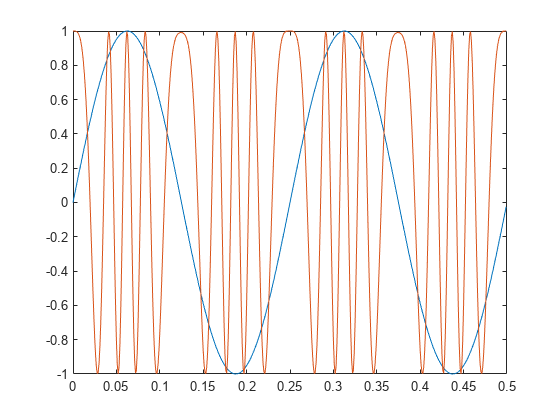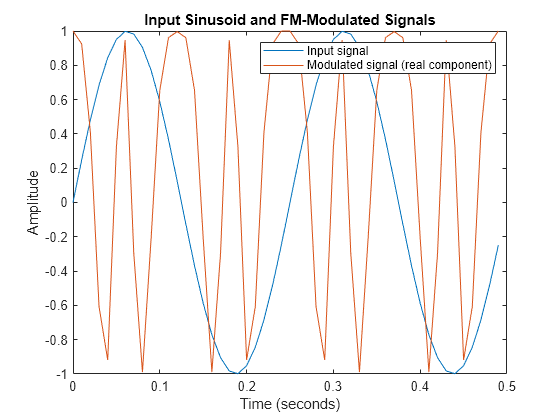comm.FMModulator
Modulate signal using FM method
Description
The comm.FMModulator
System object™ applies baseband frequency modulation to a signal. For
more information, see Algorithms.
To modulate a signal using the FM method:
Create the
comm.FMModulatorobject and set its properties.Call the object with arguments, as if it were a function.
To learn more about how System objects work, see What Are System Objects?
Creation
Syntax
Description
fmmodulator = comm.FMModulator
fmmodulator = comm.FMModulator(Name,Value)'SampleRate,400e3' specifies a sample rate of 400 kHz.
fmmodulator = comm.FMModulator(fmdemodulator)comm.FMDemodulator
System object, fmdemodulator.
Properties
Usage
Description
Input Arguments
Output Arguments
Object Functions
To use an object function, specify the
System object as the first input argument. For
example, to release system resources of a System object named obj, use
this syntax:
release(obj)
Examples
Algorithms
A frequency-modulated passband signal, Y(t), is given as
where:
A is the carrier amplitude.
fc is the carrier frequency.
x(τ) is the baseband input signal.
fΔ is the frequency deviation in Hz.
The frequency deviation is the maximum shift from fc in one direction, assuming |x(τ)| ≤ 1.
A baseband FM signal can be derived from the passband representation by downconverting the passband signal by fc such that
Removing the component at -2fc from yS(t) leaves the baseband signal representation, y(t), which is given as
The expression for y(t) can be rewritten as , where . Expressing y(t) this way implies that the input signal is a scaled version of the derivative of the phase, ϕ(t).
To recover the input signal from y(t), use a baseband delay demodulator, as this figure shows.

Subtracting a delayed and conjugated copy of the received signal from the signal itself results in this equation.
where T is the sample period. In discrete terms,
The signal vn is the approximate derivative of ϕn such that vn ≈ xn.
References
[1] Hatai, I., and I. Chakrabarti. “A New High-Performance Digital FM Modulator and Demodulator for Software-Defined Radio and Its FPGA Implementation.” International Journal of Reconfigurable Computing (December 25, 2011): 1–10. https://doi.org/10.1155/2011/342532.
[2] Taub, H., and D. Schilling. Principles of Communication Systems. McGraw-Hill Series in Electrical Engineering, 142–55. New York: McGraw-Hill, 1971.
Extended Capabilities
Version History
Introduced in R2015a



